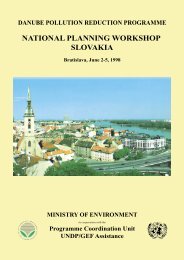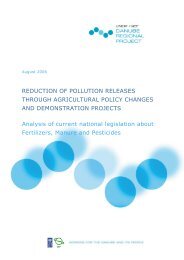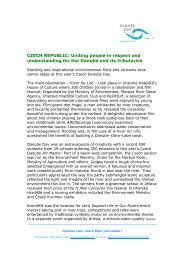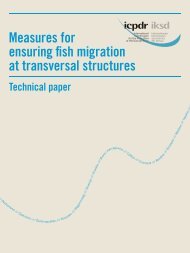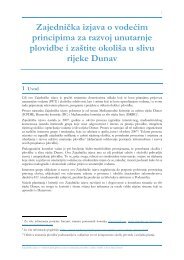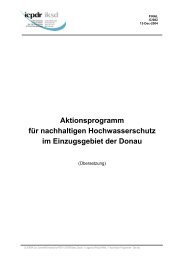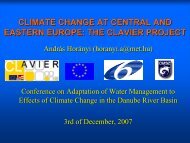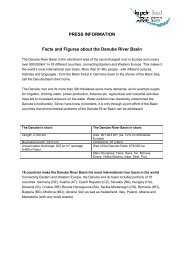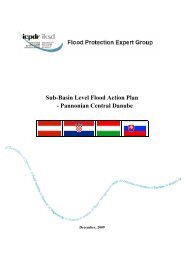Technical Reports Parts C,D - ICPDR
Technical Reports Parts C,D - ICPDR
Technical Reports Parts C,D - ICPDR
You also want an ePaper? Increase the reach of your titles
YUMPU automatically turns print PDFs into web optimized ePapers that Google loves.
136 Danube Pollution Reduction Programme – National Review, Ukraine<br />
2.5. Law and Practice on Water Pollution Control<br />
2.5.1. Legislation and Regulations<br />
According to Ukrainian environmental legislation (regulations) economic branches try to<br />
implement their policies with no deviations the “polluter pays” principle which, inter alea, foresees<br />
payments for purposive use of natural resources, for pollutions caused to the environment,<br />
including fees for effluence, as well as for the worsening of natural resources’ quality. This policy<br />
is based on a system of water quality environmental standards, which are sanitary norms similar to<br />
maximum permissible concentration, according to which utilities-polluters are given limitations for<br />
effluents. It is generally accepted, at least theoretically, that such a policy has to encourage<br />
industrial installations to save water resources and reduce volumes of effluents pursuant to fixed<br />
maximum permissible levels. This policy does not envisage establishing of “technological<br />
standards for effluents” to certain industrial facilities taking into account the capacities of available<br />
techniques since the environmental regulations of Ukraine have no provisions similar to RACT,<br />
BATNEEC or BACT principles. There are only particular branch norms for operating of clean-up<br />
facilities to be approved by the highest officials dealing with the corresponding branch. However,<br />
these norms are not prescriptive. All regulatory requirements regarding the operation of clean-up<br />
facilities are laid down by the Ministry for Environmental Protection and Nuclear Safety of<br />
Ukraine (MEPNS of Ukraine) in design documents and authorizations (licenses) for special use of<br />
water.<br />
The principal environmental regulation of Ukraine is the Ukrainian Law “On Protection of the<br />
Environment” of June 25, 1996. This law establishes the basic principles for protection of the<br />
environment. It regulates relationship in the field of protection and recovery of natural resources,<br />
ensures the environmental security, prevents deleterious effects on the environment by industrial<br />
and other activity. Another important regulation is the Water Code of Ukraine. Below are some<br />
measures aimed at compliance with the environmental regulations by utilities of no matter which<br />
form of property;<br />
<br />
the conduct of environment examination (expertise) pursuant to article 26 of the Law “On<br />
Protection of the Environment”. The procedures to conduct such an examination are<br />
established by the instruction (explanatory note of prescriptive character) that was<br />
approved by internal ordinance #15 of February 17, 1994 by the Ministry for<br />
Environmental Protection of Ukraine;<br />
fees for specials use of natural resources (Article 43), fees for causing pollutions of the<br />
environment, including fees for effluence (Article 44), fees for the worsening of the<br />
quality of natural resources (Article 45), amount of which has not been fixed yet.<br />
State and public monitoring over compliance with environmental legislation (Article 9);<br />
prevention of environmental infractions through setting constrains or suspending of<br />
environmentally hazardous activities or even cession of such activities in case of<br />
reiterative violations of environmental security norms and requirements;<br />
various kinds of legal liability (criminal, administrative, disciplinary).<br />
<br />
The system for environmental standards currently in force in Ukraine is based on sanitary or<br />
sanitary-hygienic norms that are referred to maximum permissible concentrations, i.e. the<br />
concentrations of eventually harmful chemical combinations in air, water and ground, which do not<br />
cause pathogenic mutation or deceases following a lasting impact on human body on a day-by-day<br />
basis. Maximum permissible concentrations are also referred to in the models for pollutant<br />
dissolution in an aquedis environment that are used in order to set limits for effluents released by<br />
industrial facilities.



